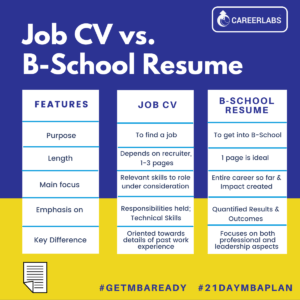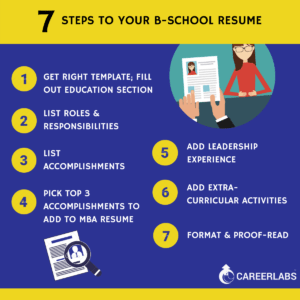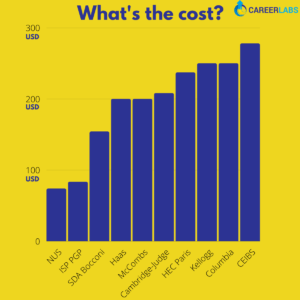It is a truth universally acknowledged, that an ambitious working professional in possession of just a good job, must be in want of a MBA- sooner or later (channeling Jane Austen here!). And hence will need a B-School Résumé as well!
In the 21-day MBA Plan, so far, you identified reasons why an MBA might be right for you, you learnt about the various types of MBA programs, weighed pros & cons for possible places to study and also got to know about the MBA Rankings. Now, let’s pause for a bit and take stock of where you stand in terms of your profile. And the first step to knowing yourself is to get your B-School resume ready.
Components of a B-School Resume
Yes, you might already have a “job” CV (a functional CV) that you used to get your current job. But the B-School Resume is different.

Since the MBA program sees applicants from so many different spheres of life and the Admissions Committee (AdCom) members reading your application may not be from your field, the B-School resume is meant to be more impact-oriented. Whether you are a lawyer or a journalist or an ophthalmologist or someone from the highly competitive pool of Indian software engineers, all that the MBA AdCom wants to know is how you contributed to your employers and how you have progressed so far. The Professional Experience section is thus critically reviewed and much time is allotted to it in application reads.
In addition to the usual Education and Professional Experience sections, for the MBA Resume, you would also want to highlight leadership skills and other extra-currricular activities. These sections show evidence of your potential to create impact not only at work but also in your community, thereby signalling potential for success in an MBA classroom (and beyond!)
So what’s the big deal?
The challenge is to fit all of these ( your long list of professional & personal accomplishments) in just one page! Yes, you heard it right! Well, sometimes, in rare cases, 2 pages are acceptable.
Some considerations
- I repeat- the B-School Resume is 1 page (TYPICALLY). So keep only the most important things. Use the MBA application form and other parts of the MBA application (essays, interviews) for showing things you had to leave out due to lack of real estate on your resume.
- List your roles using reverse chronological order (meaning your latest experience first). If you are applying to B-School, typically education section comes first. After graduation, you will mostly put the professional experience section before education. But this is no hard-and-fast rule- the idea here is to put the most significant stuff first.
- Showing a clear career progression (with all dates aligned either to the right or left) helps a lot. If there are gaps beyond 6 months, I typically suggest that you add it under a “Break” or a “Sabbatical”. The resume should show your career journey clearly but the transitions and the reasons for the job changes will all go elsewhere.
- Show how what you did mattered. Impact- this is a word you will hear very often in the B-School world. I prefer usage (and practice) of “positive impact”. Typically, impact can be seen in the results and outcomes. ONE BIG NO- please don’t list down all your job responsibilities or regurgitate your job description.
- Quantify your results as much as you can. This is one aspect that will make you stand out. It will also help the reader understand your background better and the complexity of the work you did.
- Using the right action words (start your bullet points with these) can help to showcase the extent of your abilities and competencies.
Only 7 steps to your perfect B-School Resume!

- Download your favourite B-School format (like this simple but awesome Berkeley Haas Template– more details on their Career Services here ). Complete the details in your Education Section.
- List down all your roles and responsibilities.
- List down all the accomplishments. Think, given your responsibilities, what were some of the work you were most proud of? How much more have you achieved over your peers in similar roles?
- Identify only top 3 accomplishments per role and add it to your B-School Resume.
- Add Leadership Experience or positions of responsibility you held. Include instance such as leading teams or organizing events.
- Add Extra-curricular Activities, Awards & Recognition, Volunteering experiences.
- Format the Résumé as per your preferred design and you are done!
Work on your B-School Résumé today! Check out CareerLabs here to know more about how we can help you with crafting your best B-School resume.
#21dayMBAPlan #GetMBAready #CareerLabs #MBA #Resume










